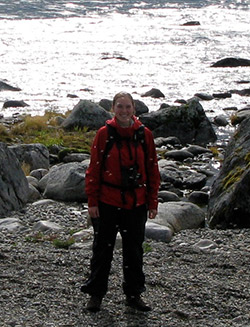Student Spotlight: Ashley Stanek, Biological Sciences Graduate Student
by Kathleen McCoy |
Growing up in Anchorage, Ashley Stanek was always involved in outdoor activities with her family, from commercial salmon fishing to camping and traveling around the state. After completing high school, Ashley attended Humboldt State University in northern California and received a Bachelor of Science degree in zoology in 2009.
After returning to Alaska, it came as no surprise that she found herself interested in pursuing science in Alaska. "I hadn't planned on studying biology, let alone going to graduate school," said Ashley. "Though looking back, it was my undergraduate biology classes I enjoyed and had found most interesting. The classes made sense, and it so far has been a good fit for me."
 In winter of 2009, Ashley began working with the U.S. Geological Survey and the Environment
and Natural Resources Institute (ENRI) Stable Isotope Lab at UAA. As fate would have
it, Professor Jeff Welker, ENRI director, had recently begun a gray wolf feeding ecology
study using isotope forensics in collaboration with the Lake Clark National Park,
and asked Ashley to consider participating as a graduate student. Without delay, she
applied to the graduate program with the biology department and was accepted as a
research assistant on the wolf study. "I hadn't planned on attending UAA, but it really
seemed to fit my needs once I started examining the program," Ashley said.
In winter of 2009, Ashley began working with the U.S. Geological Survey and the Environment
and Natural Resources Institute (ENRI) Stable Isotope Lab at UAA. As fate would have
it, Professor Jeff Welker, ENRI director, had recently begun a gray wolf feeding ecology
study using isotope forensics in collaboration with the Lake Clark National Park,
and asked Ashley to consider participating as a graduate student. Without delay, she
applied to the graduate program with the biology department and was accepted as a
research assistant on the wolf study. "I hadn't planned on attending UAA, but it really
seemed to fit my needs once I started examining the program," Ashley said.
Ashley's research focuses on examining how much salmon, as opposed to moose and caribou, the wolves in Lake Clark region are feeding on, and what role salmon may play in influencing wolf-ungulate dynamics. She can get a pretty good idea of what the wolves are eating by measuring the chemistry (stable isotopes of carbon, nitrogen and sulfur) of their hair and blood. She does this by collecting samples when wolves are captured to put tracking collars on. These collars help determine where the animals are throughout the year.
In addition, Ashley recently traveled with her colleagues to San Francisco to present some of their initial findings at the American Geophysical Union annual meeting. More than 15,000 scientists and students attended this meeting and Ashley's poster was part of a session on isotope ecology in the biogeosciences.
UAA is providing Ashley the opportunity to gain work and research experience, while taking relevant classes to enhance her research. "I'm able to explore my ideas while working with an incredibly supportive group of people," she said.
Ashley recognizes the value of access to state and federal agencies that are leading research targeted to resource, land management and conservation biology issues of the state and the north. "Students at UAA and those involved in ENRI and the biology department have an excellent opportunity to participate in agency funded research." These collaborative projects are prime opportunities for students to gain research experience that can lead to future employment, while helping students form a strong network within the state," said Ashley. She also pointed out that UAA is in a unique position to provide an educated workforce to these agencies, as almost all the major federal agencies are headquartered in Anchorage.
Ashley stresses the importance for students to reach out within their university for work experience. "I didn't realize how critical it was to be involved in a professor's lab as an undergraduate. Professors are the key in providing critical research experience and contacts," she said. Looking back, Alaska worked for Ashley, and always had--it just happened that science does, too. "Do what works and makes the most sense. I did, and I feel very grateful for the opportunities ENRI, UAA and Alaska have provided me."
 "Student Spotlight: Ashley Stanek, Biological Sciences Graduate Student" is licensed under a Creative Commons Attribution-NonCommercial 4.0 International License.
"Student Spotlight: Ashley Stanek, Biological Sciences Graduate Student" is licensed under a Creative Commons Attribution-NonCommercial 4.0 International License.









